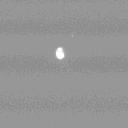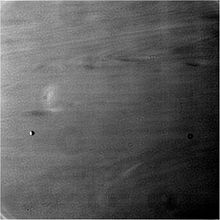Pallene (moon)
| Pallene | |
|---|---|

|
|
| Image of Pallene by the Cassini spacecraft on September 13, 2010 | |
| Provisional or systematic name | S / 2004 S 2 |
| Central body | Saturn |
| Properties of the orbit | |
| Major semi-axis | 212,280 ± 5 km |
| Periapsis | 211,430 km |
| Apoapsis | 213,130 km |
| eccentricity | 0.0040 |
| Orbit inclination | 0.1810 ± 0.0014 ° |
| Orbital time | 1.153745829 d |
| Mean orbital velocity | 13.3773 km / s |
| Physical Properties | |
| Apparent brightness | 25.0 mag |
| Medium diameter | 5.0 ± 1.2 (5.8 × 5.6 × 4.0) km |
| Dimensions | ≈ 1.7 - 7.0 10 13 kg |
| surface | 78.5 km 2 |
| Medium density | 0.5-2.0 g / cm 3 |
| Sidereal rotation | 1.153745829 |
| Axis inclination | 0 ° |
| Acceleration of gravity on the surface | 0.00035 m / s 2 |
| Escape speed | 1.388889 m / s |
| discovery | |
| Explorer | |
| Date of discovery | August 16, 2004 |
Pallene (also Saturn XXXIII ) is the thirteenth and one of the smallest of the 82 known moons of the planet Saturn . Their orbit lies between those of the large moons Mimas and Enceladus . The moons of this section, to which Methone and Anthe belong, are called the Alkyoniden group .
discovery
Pallene was discovered on August 16, 2004 by the astronomer Sébastien Charnoz together with Methone on photographs taken on June 1, 2004 by the Cassini-Huygens space probe . Charnoz is a member of the scientific team (headed by Carolyn C. Porco , Charnoz, André Brahic and Luke Dones) at Cassini-Huygens and works at the University of Paris . Since the smaller, so far undiscovered moons are extremely faint objects, the Cassini probe had taken 75 pairs of long-exposure images around Saturn. Charnoz had the recordings examined using software he developed . He found the moons Pallene and Methone.
However, it is possible that the moon was already observed by the Voyager 2 spacecraft in the 1980s. At that time, if it was Pallene, it was given the designation S / 1981 S14 . But it is also possible that these are also methones.
Pallene initially received the provisional designation S / 2004 S 2 . On January 21, 2005, the moon was named after one of the seven daughters of the giant Alkyoneus from Greek mythology (Alkyoniden). Alkyoneus was a son of Gaia and the blood of Uranus . The giant was killed in the giant battle by Herakles . Pallene and her six sisters (including Methone and Anthe) were so mournful over the death of their father that they threw themselves from the Canastra promontory into the sea. But out of pity, the Oceanid (or Nereid ) Amphitrite saved their lives and turned them into kingfishers .
Track properties
Orbit
Pallene orbits Saturn on a prograde , almost perfectly circular orbit at an average distance of 212,280 km (approx. 3,522 Saturn radii) from its center, i.e. about 152,012 km above its cloud ceiling. The orbital eccentricity is 0.004, the web is 0.181 ° relative to the equator of Saturn inclined , that is almost in the equatorial plane of the planet. Due to the low eccentricity, the orbit varies by about 1,700 km in the distance to Saturn.
The orbits of the next inner moon Anthe is on average about 14,580 km from the orbit of Pallene, the distance of the orbit of the next outer moon Enceladus is on average about 25,668 km.
Pallene orbits Saturn in 1 day, 3 hours, 41 minutes and 23.6 seconds. It takes 2 hours and 48.8 minutes longer to complete one cycle than the inner neighbor Anthe. It covers a distance of 311 ° in 24 hours.
Pallene is in gravitational interaction with the Enceladus running outside and, to a lesser extent, with the inner moon Mimas . As a result, their orbits are severely disrupted by both moons . The much larger Enceladus causes deviations in Pallene's orbit of about 4 km due to its gravity. The influence (of the orbit resonance) also causes Pallene to move back and forth on its orbit in a length of 0.02 °. The eccentricity varies at certain time intervals between 0.002 and 0.006, the inclination between 0.178 ° and 0.184 °.
Pallene ring
Despite the small size of Pallene, a ring system was discovered in front of and behind it in 2006. It is believed that the Pallene ring was probably formed from material that was knocked out of Pallene by micrometeorites . The diffuse ring extends about 2,500 km wide and, in contrast to the neighboring ring arcs of Methone and Anthe, is distributed over the entire orbit of Pallene, it is a closed ring.
rotation
The rotation time is the same as the orbital time and Pallene shows, like the earth's moon , a synchronous rotation , which also takes place within 1 day, 3 hours, 41 minutes and 23.6 seconds. The axis of rotation is inclined at 0 ° with respect to the orbit.
Physical Properties
Pallene has a mean diameter of 5.0 km. On the images from the Cassini and Voyager probes , the moon appears as a remarkably rounded body measuring 5.8 × 5.6 × 4.0 km, with the long axis oriented towards Saturn. Since the density of the moon is not fully secured, it therefore varies between 0.5 and 2.0 g / cm 3 . This results in a mass of 1.7 to 7.0 · 10 13 . If one takes an average density of 1.17 g / cm 3 as the basis for the neighboring moon Mimas , the result is a mass of 3.92 · 10 13 kg. The acceleration due to gravity is 0.35 mm / s 2 on its surface .
So far there are two theories about the origin of the three closely spaced moons Pallene, Methone and Anthe: On the one hand, they could have been broken out by Mimas or Enceladus through a collision with a comet or asteroid , on the other hand, all five moons could be residues of a larger swarm of asteroids, the Saturn got too close. Saturn would then have captured this with its gravity.
exploration
Pallene has an apparent brightness of 25.0 m , which corresponds to 1: 5 billion in relation to Saturn. Pallene has been imaged by two spacecraft so far , namely Voyager 2 on August 25, 1981 and finally by Cassini-Huygens . However, the discovery by the Voyager probe could not be confirmed, as the moon could most likely be seen on only a single image from Voyager 2 from August 23, 1981. The distance was then estimated to be around 200,000 km and therefore applies to Pallene and Methone.
Since its discovery in 2004, its orbital parameters have been made more precise by the Cassini probe, which has been orbiting Saturn since July 1, 2004. Cassini's closest flyby occurred on October 16, 2010, when the Pallene probe passed at a distance of 36,000 km, but there was no targeted flyby.
Web links
- IAUC 8389: S / 2004 S 1 and S / 2004 S 2 August 16, 2004 (discovery)
- IAUC 8471: Satellites of Saturn January 21, 2005 (numbering and naming)
Individual evidence
- ↑ Paul Rincon: Saturn overtakes Jupiter as planet with most moons. BBC , October 7, 2019, accessed March 20, 2020 .
- ↑ solarsystem.nasa.gov ( Memento from August 1, 2007 in the Internet Archive )
- ↑ iopscience.iop.org
| further inside | Saturn moons | further outside |
| Anthe |
Semi-major axis (km) Pallene 211,000 |
Enceladus |


